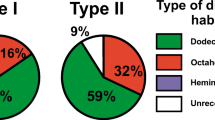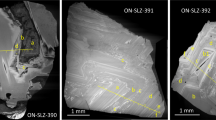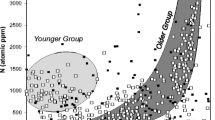Abstract
Fibrous diamonds are often interpreted as direct precipitates of primary carbonate-bearing fluids in the lithospheric mantle, sourced directly from common reservoirs of “mantle” carbon and nitrogen. Here we have examined fibrous growth layers in five diamonds (as three rims or “coats” and two whole-crystal cuboids) from the Diavik Diamond Mine, Canada, using in situ C- and N-isotope and N-abundance measurements to investigate the origin and evolution of their parental fluids, and in particular, to test for isotopic variability within a suite of fibrous diamonds. High-resolution growth structure information was gleaned from cathodoluminescence (CL) imaging and, in combination with the isotopic data, was used to assess the nature of the transition from gem to fibrous growth in the coated diamonds. The two cuboids are characterized by fine concentric bands of fibrous and/or milky opaque diamond, with one sample (S1719) having intermittent gem-like growth layers that are transparent and colourless. The three coated diamonds comprise octahedral gem cores mantled by massive or weakly zoned fibrous rims, with sharp and well-defined gem–fibrous boundaries. For the two cuboid samples, δ 13C and δ 15N values were −7.7 to −3.2 ‰ (mean −6.3 ± 1.3 ‰; 1 SD; n = 84) and −5.6 to −2.1 ‰ (mean −4.0 ± 0.8 ‰; 1 SD; n = 48), respectively. The three fibrous rims have combined δ 13C values of −8.3 to −4.8 ‰ (mean −6.9 ± 0.7 ‰; 1 SD; n = 113) and δ 15N values of −3.8 to −1.9 ‰ (mean −2.7 ± 0.4 ‰; 1 SD; n = 43). N-abundances of the combined cuboid–fibrous rim dataset range from 339 to 1714 at. ppm. The gem cores have δ 13C and δ 15N values of −5.4 to −3.5 ‰ and −17.7 to +4.5 ‰, respectively, and N-abundances of 480 to 1699 at. ppm. Broadly uniform C- and N-isotope compositions were observed in each of the gem cores (variations of ~<1 ‰ for carbon and ~<3 ‰ for nitrogen). This limited C- and N- isotope variability implies that the gem cores formed from separate pulses of fluid that remained isotopically uniform throughout the duration of growth. Significant isotopic and abundance differences were observed between the gem and fibrous growth zones, including in one detailed isotopic profile δ 13C and δ 15N offsets of ~−2.4 and ~−3.7 ‰, respectively, and a ~230 at. ppm increase in N-abundance. Combined with the well-defined gem–fibrous boundaries in plane light and CL, these sharp isotopic differences indicate separate parental fluid histories. Notably, in the combined fibrous diamond dataset prominent C- and N-isotope differences between the whole-crystal cuboid and fibrous rim data were observed, including a consistent ~1.3 ‰ offset in δ 15N values between the two growth types. This bimodal N-isotope distribution is interpreted as formation from separate parental fluids, associated with distinct nitrogen sources. The bimodal N-isotope distribution could also be explained by differences in N-speciation between the respective parental fluids, which would largely be controlled by the oxidation state of the fibrous rim and cuboid growth environments (i.e., N2 vs. NH4 + or NH3). We also note that this C- and N-isotope variability could indicate temporal changes to the source(s) of the respective parental fluids, such that each stage of fibrous diamond growth reflects the emplacement of separate pulses of proto-kimberlitic fluid—from distinct carbon and nitrogen sources, and/or with varying N-species—into the lithospheric mantle.








Similar content being viewed by others
References
Boyd SR, Pillinger CT (1994) A preliminary study of 15N/14N in octahedral growth form diamonds. Chem Geol 116:43–59
Boyd SR, Mattey DP, Pillinger CT, Milledge HJ, Mendelssohn M, Seal M (1987) Multiple growth events during diamond genesis: an integrated study of carbon and nitrogen isotopes and nitrogen aggregation state in coated stones. Earth Planet Sci Lett 86:341–353. doi:10.1016/0012-821X(87)90231-7
Boyd SR, Pillinger CT, Milledge HJ, Seal MJ (1992) C and N isotopic composition and the infrared absorption spectra of coated diamonds: evidence for the regional uniformity of CO2H2O rich fluids in lithospheric mantle. Earth Planet Sci Lett 108:139–150
Boyd SR, Pineau F, Javoy M (1994) Modelling the growth of natural diamonds. Chem Geol 116:29–42
Bulanova GP, Pearson DG, Hauri EH, Griffin BJ (2002) Carbon and nitrogen isotope systematics within a sector-growth diamond from the Mir kimberlite, Yakutia. Chem Geol 188:105–123
Cartigny P (2005) Stable isotopes and the origin of diamond. Elements 1:79–84. doi:10.2113/gselements.1.2.79
Cartigny P, Boyd SR, Harris JW, Javoy M (1997) Nitrogen isotopes in peridotitic diamonds from Fuxian, China: the mantle signature. Terra Nova 9:175–179
Cartigny P, Harris JW, Javoy M (2001) Diamond genesis, mantle fractionations and mantle nitrogen content: a study of δ13C–N concentrations in diamonds. Earth Planet Sci Lett 185:85–98
Cartigny P, Harris JW, Taylor A, Davies R, Javoy M (2003) On the possibility of a kinetic fractionation of nitrogen stable isotopes during natural diamond growth. Geochim Cosmochim Acta 67:1571–1576. doi:10.1016/S0016-7037(03)00028-0
Cartigny P, Palot M, Thomassot E, Harris JW (2014) Diamond Formation: a Stable Isotope Perspective. Annu Rev Earth Planet Sci 42:699–732. doi:10.1146/annurev-earth-042711-105259
Chacko T, Mayeda TK, Clayton RN, Goldsmith JR (1991) Oxygen and carbon isotope fractionations between CO2 and calcite. Geochim Cosmochim Acta 55:2867–2882
Davies RM, Griffin WL, O’Reilly SY, Andrew AS (2003) Unusual mineral inclusions and carbon isotopes of alluvial diamonds from Bingara, eastern Australia. Lithos 69:51–66. doi:10.1016/S0024-4937(03)00048-3
De Stefano A, Kopylova MG, Cartigny P, Afanasiev V (2009) Diamonds and eclogites of the Jericho kimberlite (Northern Canada). Contrib Mineral Petrol 158:295–315. doi:10.1007/s00410-009-0384-7
Deines P (1980) The carbon isotopic composition of diamonds: relationship to diamond shape, color, occurrence and vapor composition. Geochim Cosmochim Acta 44:943–961. doi:10.1016/0016-7037(80)90284-7
Deines P, Harris JW, Spear PM, Gurney JJ (1989) Nitrogen and 13C content of Finsch and Premier diamonds and their implications. Geochim Cosmochim Acta 53:1367–1378
Fitzsimons ICW, Harte B, Chinn IL, Gurney JJ, Taylor WR (1999) Extreme chemical variation in complex diamonds from George Creek, Colorado: a SIMS study of carbon isotope composition and nitrogen abundance. Mineral Mag 63:857–878
Gurney JJ, Helmstaedt HH, Richardson SH, Shirey SB (2010) Diamonds through time. Econ Geol 105:689–712
Harte B, Fitzsimons ICW, Harris JW, Otter ML (1999) Carbon isotope ratios and nitrogen abundances in relation to cathodoluminescence characteristics for some diamonds from the Kaapvaal Province, S. Africa. Mineral Mag 63:829–856
Hauri EH, Wang J, Pearson DG, Bulanova GP (2002) Microanalysis of δ13C, δ15N, and N abundances in diamonds by secondary ion mass spectrometry. Chem Geol 185:149–163
Howell D, Stern RA, Griffin WL, Southworth R, Mikhail S, Stachel T (2015a) Nitrogen isotope systematics and origins of mixed-habit diamonds. Geochim Cosmochim Acta 157:1–12
Howell D, Griffin WL, Yang J, Gain S, Stern RA, Huang JX, Jacob DE, Xu X, Stokes AJ, O’Reilly SY, Pearson NJ (2015b) Diamonds in ophiolites: contamination or a new diamond growth environment? Earth Planet Sci Lett 430:284–295. doi:10.1016/j.epsl.2015.08.023
Izraeli ES, Harris JW, Navon O (2001) Brine inclusions in diamonds: a new upper mantle fluid. Earth Planet Sci Lett 187:323–332
Izraeli ES, Harris JW, Navon O (2004) Fluid and mineral inclusions in cloudy diamonds from Koffiefontein, South Africa. Geochim Cosmochim Acta 68:2561–2575
Javoy M, Pineau F (1991) The volatiles record of a “popping” rock from the Mid-Atlantic Ridge at 14 N: chemical and isotopic composition of gas trapped in the vesicles. Earth Planet Sci Lett 107:598–611
Javoy M, Pineau F, Delorme H (1986) Carbon and nitrogen isotopes in the mantle. Chem Geol 57:41–62
Kamiya Y, Lang AR (1965) On the structure of coated diamonds. Philos Mag 11:347–356. doi:10.1080/14786436508221861
Kerrich R, Jia Y, Manikyamba C, Naqvi SM (2006) Secular variations of N-isotopes in terrestrial reservoirs and ore deposits. Memoir Geol Soc Am 198:81–104
Kirkley MB, Gurney JJ, Otter ML, Hill SJ, Daniels LR (1991) The application of C isotope measurements to the identification of the sources of C in diamonds: a review. Appl Geochem 6:477–494
Klein-BenDavid O, Izraeli ES, Hauri E, Navon O (2004) Mantle fluid evolution—a tale of one diamond. Lithos 77:243–253
Klein-BenDavid O, Wirth R, Navon O (2007) Micrometer-scale cavities in fibrous and cloudy diamonds—a glance into diamond dissolution events. Earth Planet Sci Lett 264:89–103
Klein-BenDavid O, Logvinova AM, Schrauder M, Spetius ZV, Weiss Y, Hauri EH, Kaminsky FV, Sobolev NV, Navon O (2009) High-Mg carbonatitic microinclusions in some Yakutian diamonds-a new type of diamond-forming fluid. Lithos 112:648–659
Klein-BenDavid O, Pearson DG, Nowell GM, Ottley C, McNeill JCR, Cartigny P (2010) Mixed fluid sources involved in diamond growth constrained by Sr-Nd-Pb-C-N isotopes and trace elements. Earth Planet Sci Lett 289:123–133
Klein-BenDavid O, Pearson DG, Nowell GM, Ottley C, McNeill JCR, Logvinova A, Sobolev NV (2014) The sources and time-integrated evolution of diamond-forming fluids—trace elements and isotopic evidence. Geochim Cosmochim Acta 125:146–169. doi:10.1016/j.gca.2013.09.022
Kung CC, Clayton RN (1978) Nitrogen abundances and isotopic compositions in stony meteorites. Earth Planet Sci Lett 38:421–435
Li Y, Keppler H (2014) Nitrogen speciation in mantle and crustal fluids. Geochim Cosmochim Acta 129:13–32. doi:10.1016/j.gca.2013.12.031
Mikhail S, Sverjensky DA (2014) Nitrogen speciation in upper mantle fluids and the origin of Earth’s nitrogen-rich atmosphere. Nat Geosci. doi:10.1038/ngeo2271
Milledge HJ, Mendelssohn MJ, Seal M, Rouse JE, Swart PK, Pillinger CT (1983) Carbon isotopic variation in spectral type II diamonds. Nature 303:791–792
Nadeau S, Pineau F, Javoy M, Francis D (1990) Carbon concentrations and isotopic ratios in fluid-inclusion-bearing upper-mantle xenoliths along the northwestern margin of North America. Chem Geol 81:271–297. doi:10.1016/0009-2541(90)90051-8
Navon O, Hutcheon ID, Rossman GR, Wasserburg GJ (1988) Mantle-derived fluids in diamond micro-inclusions. Nature 335:784–789. doi:10.1038/335784a0
Palot M, Cartigny P, Harris JW, Kaminsky FV, Stachel T (2012) Evidence for deep mantle convection and primordial heterogeneity from nitrogen and carbon stable isotopes in diamond. Earth Planet Sci Lett 357–358:179–193
Palot M, Pearson DG, Stern RA, Stachel T, Harris JW (2013) Multiple growth events, processes and fluid sources involved in diamond genesis: a micro-analytical study of sulphide-bearing diamonds from Finsch mine, RSA. Geochim Cosmochim Acta 106:51–70. doi:10.1016/j.gca.2012.12.024
Palot M, Pearson DG, Stern RA, Stachel T, Harris JW (2014) Isotopic constraints on the nature and circulation of deep mantle C–H–O–N fluids: carbon and nitrogen systematics within ultra-deep diamonds from Kankan (Guinea). Geochim Cosmochim Acta 139:26–46. doi:10.1016/j.gca.2014.04.027
Petts DC, Chacko T, Stachel T, Stern RA, Heaman LM (2015) A nitrogen isotope fractionation factor between diamond and its parental fluid derived from detailed SIMS analysis of a gem diamond and theoretical calculations. Chem Geol 410:188–200. doi:10.1016/j.chemgeo.2015.06.020
Polyakov VB, Kharlashina NN (1995) The use of heat capacity data to calculate carbon isotope fractionation between graphite, diamond, and carbon dioxide: a new approach. Geochim Cosmochim Acta 59:2561–2572
Schrauder M, Navon O (1994) Hydrous and carbonatitic mantle fluids in fibrous diamonds from Jwaneng, Botswana. Geochim Cosmochim Acta 58:761–771. doi:10.1016/0016-7037(94)90504-5
Shilobreeva S, Martinez I, Busigny V, Agrinier P, Laverne C (2011) Insights into C and H storage in the altered oceanic crust: results from ODP/IODP Hole 1256D. Geochim Cosmochim Acta 75:2237–2255
Shiryaev AA, Izraeli ES, Hauri EH, Zakharchenko OD, Navon O (2005) Chemical, optical, and isotopic investigations of fibrous diamonds from brazil. Geol Geofiz 46:1207–1222
Smart KA, Chacko T, Stachel T, Muehlenbachs K, Stern RA, Heaman LM (2011) Diamond growth from oxidized carbon sources beneath the Northern Slave Craton, Canada: a δ13C-N study of eclogite-hosted diamonds from the Jericho kimberlite. Geochim Cosmochim Acta 75:6027–6047. doi:10.1016/j.gca.2011.07.028
Sobolev VS, Sobolev NV (1980) New proof of very deep subsidence of eclogitized crystal rocks. Dokl Akad Nauk SSSR 250:683–685
Stachel T, Harris JW, Muehlenbachs K (2009) Sources of carbon in inclusion bearing diamonds. Lithos 112:625–637. doi:10.1016/j.lithos.2009.04.017
Stern RA, Palot M, Howell D, Stachel T, Pearson DG, Cartigny P, Oh A (2014) Methods and reference materials for SIMS diamond C- and N-isotope analysis [WWW Document]. era.library.ualberta.ca. http://hdl.handle.net/10402/era.38738. Accessed 29 April 14
Thomassot E, Cartigny P, Harris JW, Fanus Viljoen KS (2007) Methane-related diamond crystallization in the Earth’s mantle: stable isotope evidences from a single diamond-bearing xenolith. Earth Planet Sci Lett 257:362–371
Weiss Y, Kessel R, Griffin WL, Kiflawi I, Klein-BenDavid O, Bell DR, Harris JW, Navon O (2009) A new model for the evolution of diamond-forming fluids: evidence from microinclusion-bearing diamonds from Kankan, Guinea. Lithos 112:660–674
Weiss Y, Griffin WL, Bell DR, Navon O (2011) High-Mg carbonatitic melts in diamonds, kimberlites and the sub-continental lithosphere. Earth Planet Sci Lett 309:337–347. doi:10.1016/j.epsl.2011.07.012
Weiss Y, Kiflawi I, Davies N, Navon O (2014) High-density fluids and the growth of monocrystalline diamonds. Geochim Cosmochim Acta 141:145–159. doi:10.1016/j.gca.2014.05.050
Weiss Y, McNeill J, Pearson DG, Nowell GM, Ottley CJ (2015) Highly saline fluids from a subducting slab as the source for fluid-rich diamonds. Nature 524:339–342. doi:10.1038/nature14857
Wiggers de Vries DF, Bulanova GP, De Corte K, Pearson DG, Craven JA, Davies GR (2013) Micron-scale coupled carbon isotope and nitrogen abundance variations in diamonds: evidence for episodic diamond formation beneath the Siberian Craton. Geochim Cosmochim Acta 100:176–199. doi:10.1016/j.gca.2012.08.034
Zedgenizov DA, Ragozin AL, Shatsky VS, Araujo D, Griffin WL (2011) Fibrous diamonds from the placers of the northeastern Siberian Platform: carbonate and silicate crystallization media. Russ Geol Geophys 52:1298–1309. doi:10.1016/j.rgg.2011.10.003
Acknowledgments
We thank Anna Oh for technical support in the CCIM laboratory. Tom Chacko is acknowledged for valuable discussions on C- and N-isotope isotope systematics of diamond-forming fluids. We are appreciative of Sami Mikhail for providing us with worldwide C- and N-isotope data for fibrous diamonds. We gratefully acknowledge Oded Navon and one anonymous reviewer, whose comments and suggestions have greatly improved the manuscript. We are grateful to Diavik Diamond Mines Inc. for sample donation and for financial support through an NSERC Collaborative Research and Development Grant held by TS. Additional financial support for this research was provided by an NSERC Discovery Grant to TS.
Author information
Authors and Affiliations
Corresponding author
Additional information
Communicated by Othmar Müntener.
Electronic supplementary material
Below is the link to the electronic supplementary material.
Rights and permissions
About this article
Cite this article
Petts, D.C., Stachel, T., Stern, R.A. et al. Multiple carbon and nitrogen sources associated with the parental mantle fluids of fibrous diamonds from Diavik, Canada, revealed by SIMS microanalysis. Contrib Mineral Petrol 171, 17 (2016). https://doi.org/10.1007/s00410-016-1231-2
Received:
Accepted:
Published:
DOI: https://doi.org/10.1007/s00410-016-1231-2




